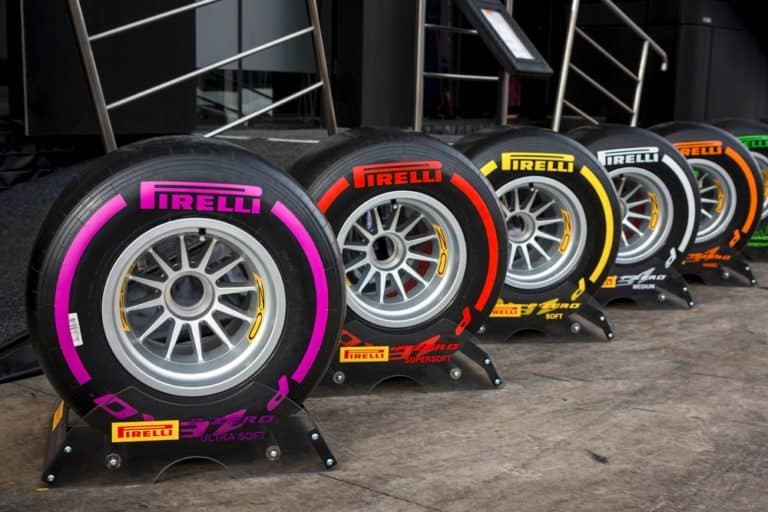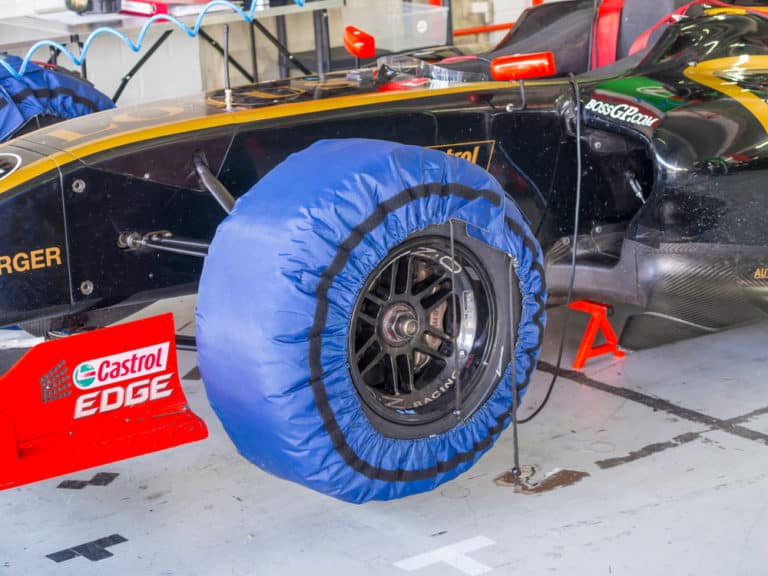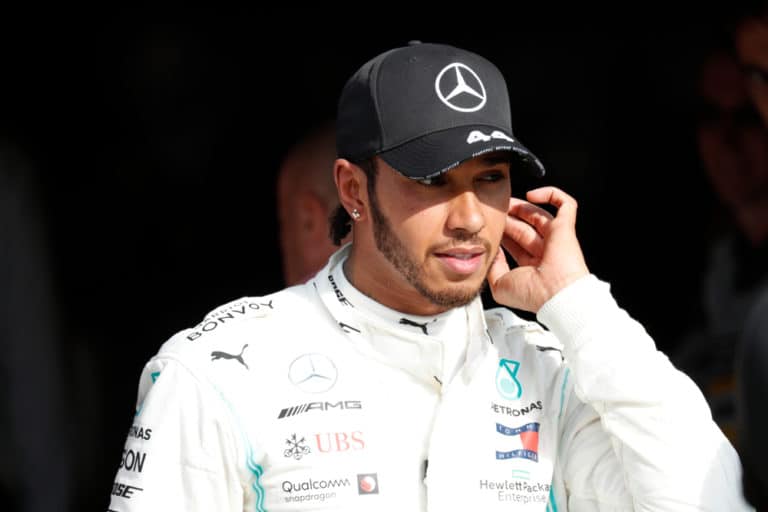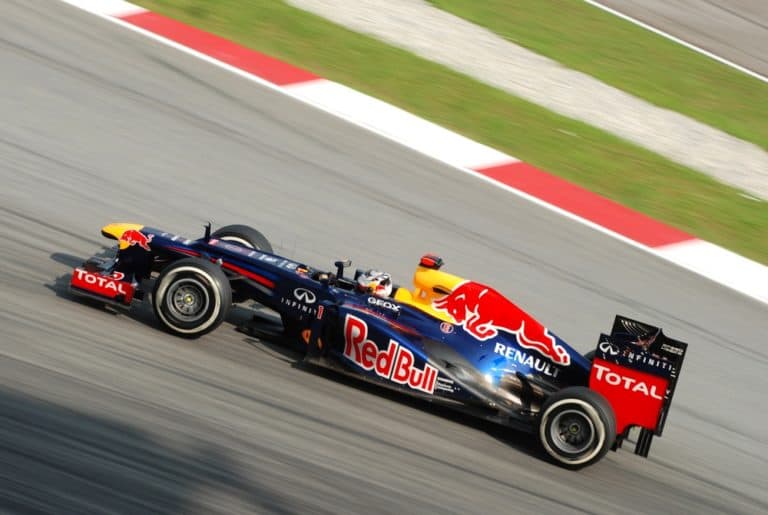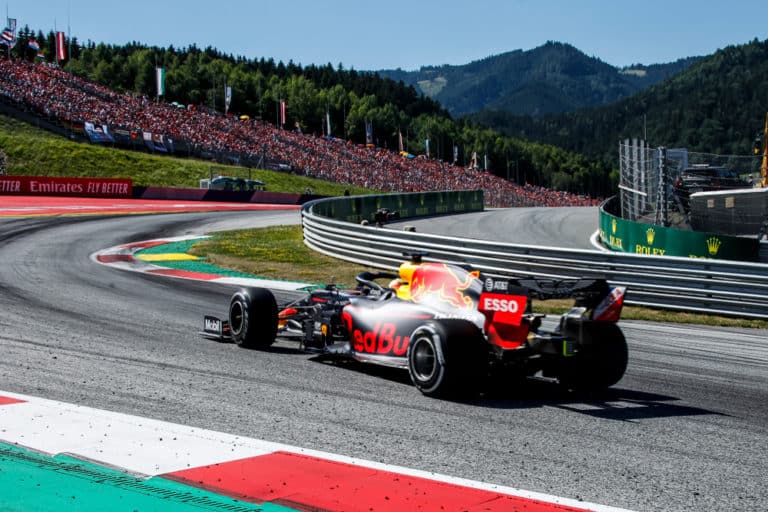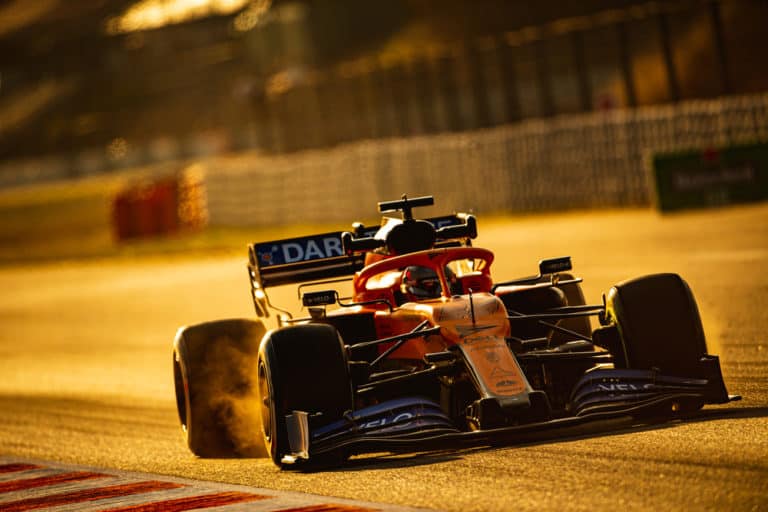There are two iconic names associated with the Formula engines that power the latest breed of vehicles in the current era. Mercedes, because of the sheer dominance this engine manufacturer has held on the sport, and Ferrari, because of the historical importance this team is to Formula 1.
The best F1 engine manufacturer was Coventry Climax which won over 40% of all the races in which their engines were used. Mercedes are the dominant force in the modern era and have won the last eight world championships. Ferrari is the only company to have entered every year since 1951.
Since the first F1 race at Silverstone, 70 engine manufacturers have built power units for various F1 teams. Of these, only 23 have ever achieved a pole position on the F1 starting grid, 36 earned a podium finish, but only 19 won an F1 race.
If you’re looking for some F1 merchandise, check out the awesome stuff at the official F1 store here.
The Identity Of the Best Manufacturer Will Surprise You
Former British Prime Minister Benjamin Disraeli once said: “There are three kinds of lies: lies, damned lies, and statistics.”
Identifying the best F1 engine manufacturer could make us fall into this trap. Let’s look at the metrics we could use to determine which F1 engine manufacturer was the best.
The Number Of Races Won
It may be a valid measurement. If we chose this score, the problem would be that the best engine manufacturer would end as the company which has participated for the most extended period.
A manufacturer which had only participated for five years but had won 50% of all the races their engine participated in would probably not feature.
The Number Of Constructor Championships Won
Once again, this would seem to be a valid way of assessing the best engine manufacturer. Once again, this would result in a bias towards companies that had built f1 engines for the longest time.
An engine manufacturer who has participated for three years and won constructors title every year (i.e., a 100% success rate) would not fare as well as Honda which has won the constructors title four times but entered the competition 27 times.
The Best Measure Is The No Of Race Won Against Races Entered.
By calculating the percentage of the number of races the manufacturer won against the number of races entered, we will arrive at an accurate measure of the manufacturer’s ability to build race-winning engines.
The results are fascinating and include some unexpected names. The companies you would expect to see on this list, such as Ferrari and Honda (Red bull), appear in much lower positions than the other names.
| Name Of Engine Manufacturer | Country They Operate From | Number Of Races Entered | Number Of Races They Started | Number Of Races Won | Percentage Of Races Won |
| Coventry Climax | United Kingdom | 97 | 96 | 40 | 41.24% |
| Mercedes | United Kingdom | 521 | 519 | 211 | 40.50% |
| TAG | Germany | 68 | 68 | 25 | 36.76% |
| Ford | United Kingdom | 528 | 523 | 176 | 33.33% |
| Vanwall | United Kingdom | 29 | 28 | 9 | 31.03% |
| Renault | France | 682 | 679 | 169 | 24.78% |
| Repco | Australia | 33 | 33 | 8 | 24.24% |
| Ferrari | Italy | 1036 | 1032 | 239 | 23.07% |
| Honda | Japan | 482 | 481 | 89 | 18.46% |
The following section traces provides more details about these manufacturers.
Coventry Climax Achieved The Highest Win Rate (41.24%)
Coventry climax started providing engines to power formula cars in 1957, seven years after the competition formally started.
The company first opened its doors in 1917, just before World War 1 ended, and had a factory situated in Coventry In the United Kingdom.
The company was purchased by the Pelham Lee family, who intended to supply motor vehicle engines to the many car manufacturers active in Coventry through the 1920s.
When one of these manufacturers (Swift Motors) collapsed in 1931, Coventry Climax was left with too large a stockpile, so they converted the units into gas generators.
They found a ready market for the generator with fire brigades across the country, who used the generators to power the water pumps.
After World War 2 ended, the company shifted from manufacturing car engines and instead manufactured diesel engines for marine uses, fire pumps, and forklift trucks.
The Company Enters Formula 1
In 1954 the company developed an engine to run in the 1954 24 Hours of Le Man’s race.
In 1956 they produced their first Formula 1 engine, which they used to power a Cooper racing chassis. Stirling Moss scored the company’s first Formula One victory in Argentina in 1958, and they would go on to achieve 40 F1 races by 1969.
When they listed the company on the stock exchange in 1960, Jaguar cars bought 100% of the stock allocation. Jaguar was merged with British Leyland, which was the death knell of the British motor industry.
British Leyland sold it off in 1982 and privately ran it until entering receivership in 1986. Fortunately, in 2009, the cargo handling company, Kalmar, acquired the company and moved production to Shrewsbury in the United Kingdom.
Although the company is not involved in motorsport, it is good news that it is still operational.
Mercedes Is The Second-Best Engine Manufacturer (40.50%)
Mercedes has dominated the F1 world for the last eight years.
This formidable company has participated in F1, off and on since the French Grand Prix in 1954.
The F1 Mercedes cars, which this first racing engine powered, were open and closed wheel vehicles. The first driver of a Mercedes-powered vehicle in 1954 was the legendary Juan Manuel Fangio, who won the championship in the second year of the competition – 1951.
In Mercedes’s first year in 1954, it achieved both 1st and 2nd place in the championship.
The manufacturer developed the model W196 engine throughout 1954 and once again dominated the 1955 season. Stirling Moss joined the team in 1955, and Fangio and Moss came 1st and 2nd in the competition. It was a pyrrhic victory for Mercedes because their LeMans driver, Pierre Levegh, and more than 80 spectators were killed in a horrific accident at the 24 Hours of LeMans race on 11 June.
Following this, Mercedes cut all ties with racing.
Interestingly, Mercedes raced a closed-wheel car during the 1950s and is credited as the only company to have won a Grand Prix in this configuration.
Daimler Invests In An Engine Manufacturer
In 1993 Daimler-Benz acquired a 25% share of the engine supplier Ilmor, a small engine supplier in the United Kingdom. Mercedes would not allow their branding on these vehicles, and instead, they called them Sauber’s.
After a strong performance in 1993, Ilmor persuaded Mercedes to become more involved, and Ilmor became McLaren’s engine partner in 1995. The McLaren/Ilmor partnership won its first race at the 1997 Australian Grand Prix. Mika Häkkinen picked up driver’s championships in 1998 and 1999, and the team won the constructor’s championship in 1998.
In 2001, Paul Morgan, one of the co-founders of Ilmor, was killed when his Hawker Sea Fury overturned on landing at Sywell Aerodrome, Northamptonshire. Morgan’s widow wanted to reduce her shareholding, which Mercedes-Benz took up.
Mercedes Enters The Scene
The company was renamed Mercedes-Ilmor Ltd, and in 2005, Daimler bought the balance of the shares and became the sole owner.
They renamed the company Mercedes-Benz High-Performance Engines, later changing to Mercedes-Benz HighPerformanceEngines.
McLaren did not win again until a rookie in his first season won the championship in 2008. The rookie was a young man named Lewis Hamilton, and this represented the beginning of a new era.
It would not be until 2010, when Daimler Benz purchased a 45.1% in the Brawn GP team, that the company would return as an official constructor in Formula 1.
The now rebranded Mercedes F1 team hired German drivers Nico Rosberg and seven-time world champion Michael Schumacher as the first drivers of this era. As it is said, the rest is history. Mercedes has won eight back-to-back constructor championships between 2014 to 2021.
The Team Which Is Third Best Is TAG (36.76%)
One of the most exciting and enduring partnerships has been the three-way grouping of Techniques D’Avant-Garde (TAG), well-known for their F1 watches, the McLaren F1 team, and Porsche.
In 1983 Ron Dennis of McLaren offered Mansour Ojjeh of TAG a sponsorship deal and part ownership of the McLaren. This partnership continues today, and TAG owns 14% of the McLaren group.
TAG provided the investment necessary; Porsche created the engine, and McLaren produced the chassis.
McLaren was using a Porsche developed and manufactured engine for the years 1983 through to 1987. The Porsche-TAG TTE P01 engine was one of the most dominant Formula 1 power units
designed exclusively for McLaren.
The results were exceptional, with the car going on to win.
- 25 out of 69 races
- 2 constructors’ championships
- 3 drivers’ championships.

Ford Was A Dominant F1 Engine Manufacturer (33.33%)
Perhaps the most iconic Formula 1 engine ever developed was the Ford Cosworth DFV, produced between 1968 and 1985.
The Cosworth saw life following a deal between Lotus, Ford, and Cosworth.
Although the original agreement stated this would be an exclusive engine for Lotus, Ford was concerned at how this would look and backtracked by offering to make it available to Cosworth customer teams from 1969 onwards.
The legend of the Cosworth engine came from its small dimensions with good levels of power. It was cheaper to produce and developed a name as a low-cost, high-efficiency power unit for the sport.
The way it was mounted saved weight and improved the chassis stiffness.
The Ford Cosworth engine was used by
- Lotus
- Jordan
- Fondmetal
- Benetton
- McLaren
Its final race was the 1985 Austrian Grand Prix.
The F1 cars powered by the Ford / Cosworth engine won 176 out of 523 races, 10 constructor titles, and 13 driver championship games.
Vanwall Was The Fifth Best Manufacturer (31.03%)
Vanwall’s position on this wall of fame is a slight statistical anomaly.
The company’s founder, Tony Vandervell, was one of the original backers of British Racing Motors when he entered several modified Ferraris in Formule Libre races under the name “Thinwall Special.”
The company was both a constructor and engine manufacturer during the 1950s
Between 1954 and 1960, Vanwall engines started in 29 F1 races and won 9. It also managed to win the constructors championship in 1958.
Sterling Moss led the team to victory for the first time in 1957 at the British Grand Prix.
The 1958 season was the last one in which Vanwall entered every race. His health was failing, and his doctors advised him to rest. The team continued half-heartedly until the 1960 French Grand Prix, when they closed the motorsport division.
Tony Vandervell died on 10 March 1967.
6th On The List Is Renault (24.78%)
Renault has had three formal stints in Formula One and has been surprisingly successful.
Renault was a late arrival on the Formula 1 scene compared to other manufacturers. The company’s first stint in Formula 1 was from 1977 to 1985.
1977 – 1985 was Renault’s worst and best period)
1977, Renault’s subsidiary, Renault Sport, entered only one car driven by Jean-Pierre Jabouille.
The car was called the Renault RS01 and was powered by the first Turbo Charged unit ever used in F1. The car and engine were unreliable and became a joke during its first races. Other teams dubbed it the “Yellow Teapot,” failing to finish any races.
It would not be until the South Africa Grand Prix in 1979 that the team’s fortunes would start to improve. In South Africa, they achieved their first pole position.
Later in the same season, at Dijon in France, Renault achieved a first and second race win for both cars. It was the first time in Formula One race that a turbocharged car had won.
In 1980 the turbocharged engine showed its mettle at the high-powered circuits in Brazil and South Africa, winning both times.
Alain Prost joined the team in 1981 and would remain for the next three years. Twice Prost finished third in the Constructors’ Championships and once second.
Prost won nine races with the team. The team fired him at the end of the 1983 season because of the derogatory way he spoke about Renault.
At the end of 1985, Renault stopped competing in F1 and would not return until 2002.
Renault Returns To F1
In 2000, Renault purchased Benetton Formula Limited, which allowed it to return to Formula One.
The team contested the 2002 season with Jarno Trulli and Jenson Button driving. In the first year, the team scored a good 23 points.
In 2005 the promise became a reality. In the following years, Renault achieved
- 2006 – 1st place
- 2007 – 3rd place
- 2008 – 4th place
- 2009 – 8th place
- 2010 – 5th place
- 2011 – 5th place
- 2012 – 4th place (racing as Lotus Renault)
- 2013 – 4th place (racing as Lotus Renault)
- 2014 – 8th place (racing as Lotus Renault)
- 2015 – 7th place (racing as Lotus Renault)
- 2016 – 9th place (Renault returned to Formula One as a full-works constructor team)
- 2017 – 6th place
- 2018 – 4th place
- 2019 – 5th place
- 2020 – 5th place
- 2021 – 5th place
And In 7th Place, We Have – REPCO (24.24%)
Repco is an Australian company that specializes in spare parts and motor accessories.
The company provided the power units for Jack Brabham’s Brabham Formula One cars from 1966 to 1969.
For the 1966 season, the FIA ruled that F1 engines would return to being high-powered units. This announcement forced our winner, Coventry Climax, to leave F1, and Brabham was left looking for a supplier.
Jack Brabham was a friend of Phil Irving, an engineer at Repco. The resulting power plant was designated the Repco 620 V8 and was compact and lightweight and could be bolted into an existing 1.5-litre Formula One chassis. At 310 bhp (231 kW), the Repco 620 was the least powerful engine in the field.
It was also reliable, fuel-efficient, lightweight, and compact. Due to its dimensions and reduced weight, the strain on chassis, suspension, brakes, and tires was low.
In 1966 Jack Brabham’s car, powered by the Remco unit, achieved three pole positions, four consecutive wins, and both titles in the nine-races long season.
Unfortunately, with the introduction of the Ford Cosworth in the next year, Remco’s success rate started to drop.
Despite this, at the end of its three-year stint, the Repco engine had powered Brabham’s car for thirty-three races and won eight of them.
Ferrari Are The Eight Best Engine Manufacturer (23.07%)
The team is named after its founder, Enzo Ferrari. Scuderia is Italian for a stable reserved for racing horses and commonly applied to Italian motor racing teams.
Ferrari has the distinction of participating in every season of F1 from the 2nd onwards.
Ferrari did not enter the first season because Enzo Ferrari felt that the more powerful Alfa Romeo would dominate Ferrari, so he waited until Ferrari’s more powerful engine was ready for the 1952 season.
The new engine beat the Alfa Romeo unit, so he was vindicated with his decision. The story goes that Enzo cried like a baby when his team finally defeated the mighty Alfetta 159.
The prancing horse
symbolized Italian World War I ace Francesco Baracca’s fighter plane. It became Ferrari’s logo after the deceased pilot’s parents suggested that Ferrari use the symbol as the logo of the Scuderia to ‘bring him good luck.
Over the years, the red Ferrari Formula 1 cars have become a national treasure in Italy and have a fervent following. Such was the passion of Enzo Ferrari that the only reason he started to build road-going cars was to finance the company’s racing activities. This passion continues today.
Ferrari has raced in 1036 events and has won 239 of these. The team has won 16 constructors and 15 drivers’ championships. Ferrari drivers have achieved 784 podium positions and pole starting positions.
Ferrari only appears at 8th place in this article because the win percentage is 23.07%.
Only Mercedes has come close to Ferrari’s sheer number of wins.
- Ferrari 239
- Mercedes 211.
Fifteen legendary drivers have won championships racing for the iconic prancing horse. These include
- Alberto Ascari
- Juan Manuel Fangio
- Mike Hawthorn
- Phil Hill
- John Surtees
- Niki Lauda
- Jody Scheckter
- Michael Schumacher
- Kimi Räikkönen
Seven-time drivers’ championship winner Michael Schumacher won 5 consecutive championships between 1996 and 2006.
The 2020 Tuscan Grand Prix was the 1000th Grand Prix the company had participated in.
Ferrari has unique influence and power with the FIA, including an FIA-sanctioned veto on technical regulations.
At 9th Place, Honda Comes Through (18.46%)
As a constructor or engine manufacturer, Honda has participated in F1 intermittently since 1964.
The first two years of Hondas involvement were very successful, and the team won its first victory at the Mexican Grand Prix in 1965. Unfortunately, due to a problematic vehicle sales market and the death of one of their drivers, Honda left F1 in 1968.
In 1983 the company returned as an engine manufacturer and had immediate success winning races in the 1984 and 1985 seasons.
Powering both Williams and McLaren F1 cars, they won back-to-back championships for the five years between 1986 and 1991. It included winning every driver’s title between 1987 and 1991.
The winning drivers during these Golden years were
- Nelson Piquet
- Ayrton Senna
- Alain Prost
The company left F1 in 1992 after the Japanese economy suffered a massive setback with the Japanese asset price bubble.
The company returned to F1 as an engine supplier for British American Racing in 2000. BAR-Honda came second in the Constructors’ Championship in 2004.
Honda took control of the BAR team in 2005 and changed the name to Honda racing for the 2006 season.
In December 2008, the company exited Formula due to the global financial crisis.
Honda returned as the McLaren engine supplier for the three years between 2015 and 2018. They became the engine supplier for Toro Rosso in 2018 and Red Bull racing in 2019.
Honda has won six World Constructors’ Championships, six World Drivers’ Championships, and over 89 Grands Prix. They have officially left F1 for 2022 to focus their resources on carbon-neutral technologies.
Conclusion
For the last 72 years, F1 engines manufacturers have been the unsung heroes of the sport. When the cars they are powering win championships, it is rare that they receive just accolades, but if the team is experiencing a losing streak, they are an easy fall guy to take the blame.
Whether it was the move to 3.0 l engines in the 1960s, the development of V8 and V12 behemoths in later years, the introduction of Turbocharged boost systems, or the development of the hybrid technology powering today’s cars, each engine supplier has made a massive contribution.

